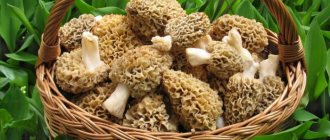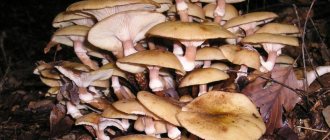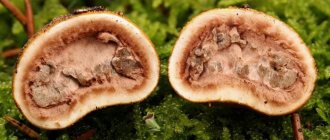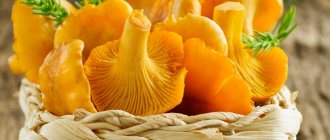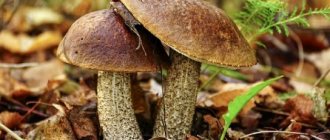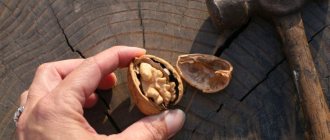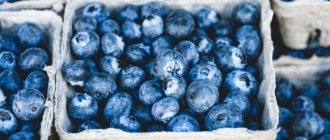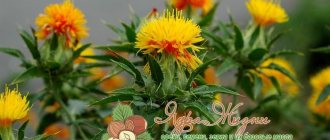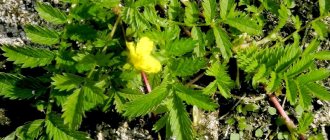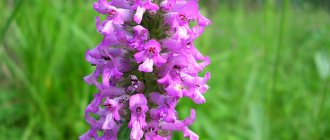Appearance
The cap is up to 12 cm in diameter, initially ovoid in shape, with edges curled down. Subsequently, the cap takes the shape of a cap, and its edge is leveled. The color of the cap is brownish, and its surface is covered with small cracks and a whitish coating.
The hymenophore is lamellar; the plates initially have a light yellow color, and with age they become rusty-brown. In the youngest fruiting bodies they are covered with a film shell. Spore powder is rusty brown in color.
The leg is up to 12 cm long and up to 3 cm in diameter, light yellowish in color, cylindrical in shape, with a thickening at the bottom. At the top there is a film ring with a small film fringe. The lower part of the leg is smooth, the upper part is covered with a slight coating.
The pulp is dense and slightly watery, white in color, with a pronounced mushroom taste and smell.
Motivation for the name
, probably based on the wavy-lobed shape of the edges of the cap of the old mushroom, reminiscent of a cockscomb.
Fixed in dictionaries: not fixed in this meaning. Synonyms: greenback, gray sandpiper Some of its varieties, indeed, over time acquire a resemblance to a cockscomb. These include gray sandpipers; in old mushrooms, the cap rises in a wave and resembles a cockscomb; it does not have a round shape. It is found mainly in sandy soils of pine forests. In mixed forests, other subspecies predominate. Their caps are round and resemble an umbrella. The peculiarity of the cap is that its edges diverge as it grows, and the lamellar part protrudes outward. You can distinguish them from cobwebs by the “skirt” on the leg. Spider webs do not have it, and even in cockerels it disappears over time. As the leg grows, the skirt becomes tight, it breaks, forming a kind of ring on the leg.
Similar species
The annular cap is very similar to spider web mushrooms, and was previously considered one of them. Its spore powder is rusty-brown in color and its almond-shaped, warty spores are the same as those of spider webs. But he never has a cobwebby veil under his hat.
The chicken mushroom is also similar to some species of voles, primarily in its color. Especially for Vole Stiff and Vole Early. Both of these mushrooms are edible and grow in spring and summer in wide open spaces - meadows or lawns. They are smaller in size than the chicken mushroom and have thin fleshy caps and thin, fibrous, hollow inside legs. The early vole has a bitter floury taste and smell.
There is a small chance of confusing Caps with the queen of poisonous mushrooms - Pale Toadstool, so you need to remember here the obvious signs of this deadly mushroom:
The cap is up to 16 cm in diameter, initially oval-round, later broadly convex, and, in old age, flat-convex, or completely flat. The skin on the cap is smooth and shiny in sunny weather, slightly sticky during rains. The color of the cap can vary from dull green and yellowish to olive and brownish. If you look closely, you can see radial fibers on the cap. Sometimes you can find completely white specimens of the Pale Toadstool. In young specimens, on the top of the cap there are often flaky remains of the spathe, inside which the embryo of the fruiting body developed, but they are less noticeable than similar scales on the red fly agaric. In older specimens, these fragments are usually washed away by rain.
The hymenophore is of the lamellar type, the plates are almost free, wide and frequent. They are white, sometimes with a greenish tint. Spore powder is white.
The leg is up to 18 cm high and up to 2.5 cm thick, smooth and cylindrical, often slightly tapering upward. It is painted the same color as the cap or almost white, covered with a light moiré pattern and slightly pubescent. At the top of the leg there is a characteristic white ring, similar to a ballerina's skirt. At the bottom, the leg is buried in the volva - the remnant of the original egg from which the toadstool's fruiting body hatched. Volva is white, loosely wraps around the leg, and is often completely hidden in the ground or leaf litter.
The pulp is fleshy, has a white color that does not change when broken. In young specimens it has a pleasant mushroom smell, in older specimens it becomes unpleasant - sweetish.
Where and When It Grows
This deadly mushroom grows in forests of all types, preferring clearings in deciduous and mixed forests. It bears fruit from June to October and is widespread in central Russia. Apparently, it forms mycorrhiza with oak, linden and birch, less often with hazel and maple.
The most obvious external signs of the Pale Toadstool:
- The lower part of the toadstool's leg is surrounded by a white sac - the volva.
- On the stem under the cap there is a characteristic large and durable white ring - a skirt.
- The plates of the hymenophore, even in old age, retain a white color, at most, with a slightly greenish bias.
- The cap is smooth, without any grooves. It usually has a greenish or brownish tint, but its color range is variable and serves as a weak guide.
Collection time and place
The ringed cap can be found almost throughout Europe and Asia, North America and the Japanese Islands. Mushrooms choose mountain coniferous forests for colonization. Preference is given to acidic soils where blueberries and lingonberries grow.
In central Russia they are most often found in mossy, slightly marshy areas. It is found almost everywhere in Belarus and enjoys well-deserved love and popularity.
Reference! The prevalence of caps in swampy areas gave people the opportunity to call them marsh bogs and marsh bogs.
From the beginning of July until the frosts, hens appear in small groups in light coniferous and mixed forests. Very often, fruiting bodies are arranged in rings (popularly called “witch’s circles”). In some areas, the cockerel is practically unknown and is considered unfit for food, despite its positive characteristics. Fruiting time is from July to early October.
Culinary use
Chicken mushroom is a good edible mushroom suitable for a variety of culinary uses. To some, its taste seems similar to the taste of champignons, to others it resembles chicken meat.
The nutritional value
In 100 gr. The Ringed Cap contains:
- Proteins – 3.09 gr.
- Fats – 0.34 gr.
- Carbohydrates – 3.26 g.
Calorie content 22 kcal
Chicken mushroom also contains water - 92.45 g, fiber - 1 g, sugar - 1.98 g, vitamins D and C, thiamine, riboflavin. And also magnesium, calcium, zinc, selenium, phosphorus, sodium, potassium and iron.
Officially, chicken mushroom belongs to food category 4, but many experts consider its taste to be truly delicious.
Preliminary preparation
Before using chicken mushrooms to prepare a variety of delicious dishes, these mushrooms need to be prepared for cooking.
- Collect only young, dense and healthy specimens of mushrooms; do not take too wormy or overripe fruiting bodies. Do not collect Caps in environmentally unsafe places - on the outskirts of large cities, near large industrial enterprises or along highways. These mushrooms are especially active in absorbing harmful substances from the air and soil.
- At home, carefully sort through the collected forest gifts, clean them of forest debris and dirt and, if necessary, remove fragments damaged by insects or rot with a knife.
- Then rinse the mushrooms thoroughly but quickly under running water.
Now the Cockerels are ready for further culinary processing.
Where do they grow
Despite its slight popularity, the mushroom grows in many European and Asian countries. Also common in the States.
The best soil for the development of colonies is considered acidic. You can determine the acidity of the soil by the plants that grow on it. If blueberries come into view, then with 100% certainty we can say that somewhere nearby there is a family of chickens.
There are a lot of chickens in Belarus. Also, they are common in central Russia in marshy areas.
They can be collected from the beginning of July until the onset of frost. These are family fruits that grow in groups. Often, the group forms a semicircle.
Unfortunately, most people consider swampweed to be poisonous and avoid it. But experienced mushroom pickers who were lucky enough to try chicken “meat” assure that they have no equal in taste.
Recipes
Below are recipes for some dishes that can be prepared from Caps.
Chicken fried mushrooms
Required:
- Mushrooms – 450 gr.
- Vegetable oil – 4 tbsp. spoons.
- Salt - to taste.
Cooking:
- Cut the fruiting bodies into arbitrary pieces and fry in a frying pan in oil for 10 minutes.
- Add salt, mix thoroughly and cook for another 35 minutes.
During frying, the liquid will actively evaporate from the chickens and by adjusting its level in the frying pan, you can also regulate the degree of browning of the mushrooms.
Chicken mushroom soup
Required:
- Mushrooms – 200 gr.
- Potatoes – 3 pcs., medium size.
- Carrots – 1 pc.
- Parsley root – 1 pc.
- Onions – 1 pc.
- Butter – 30 gr.
- Salt, pepper - to taste.
- Parsley - to taste.
Cooking:
- Cut the chicken mushrooms into small slices and the onions into medium-sized cubes.
- Fry mushrooms and onions in a frying pan in butter. When the mushrooms release their juice, scoop out most of it with a spoon.
- Cut the potatoes into cubes, carrots into cubes, and parsley root into half rings.
- Boil the vegetables in a pan of salted water for 15 minutes, then add the mushrooms and onions and cook for about 10 minutes.
- A few minutes before the end of cooking, add pepper and chopped herbs.
Preparation for the winter. Preparation
The caps can also be saved for the winter, and the best way to do this is to pickle them. Before that, however, we need to remember the basic rules for safe home canning:
How to properly sterilize jars:
- In the microwave, jars and lids should be washed with soda and mustard, and then wiped dry. Then boil the lids for 7 minutes, pour one and a half centimeters of water into the jars and rotate them for 5 minutes in the microwave at a power of 800 watts. They are eventually sterilized by hot steam from boiling water.
- In water - wash jars and lids thoroughly with laundry soap, and then boil in a large saucepan for 7 minutes. This is the simplest and most affordable way to sterilize pickling containers at home. Place the sterilized jars on a clean towel with the neck down.
- Steam - wash jars and lids thoroughly. Then boil water in a large container, put the lids directly into the water, and place the jars over the pan on a sieve or colander with their necks down. Boil for 25 minutes. The jars will be well sterilized when large drops of water appear inside them. The finished jars should be placed on a clean towel with their necks down.
- In the oven - jars and lids must be thoroughly washed and kept in the oven for 20 minutes at a temperature of 150. This method is not suitable only for lids - screws with rubber bands - they will have to be boiled separately.
How to properly preserve pickles
- The product must be placed in jars hot, immediately after preparation.
- The formation of voids inside the cans should not be allowed.
- Next, you need to put the lids on the jars, but do not screw them on yet.
- Then the jars must be disinfected again in a pan of water or oven for 15 minutes at a temperature of 120 degrees, then screw the lids tightly.
- While the jars are cooling, you need to turn them over onto the lids and wrap them tightly with some warm material. An old blanket will do, for example.
- Cooled jars should be stored in a cellar or other dark and cool place at a temperature of 0 to +8 degrees.
- You should use regular table salt. Iodized or marine can cause the product to sour. Usually 50 g is required. salt per 1 kg. mushrooms
- Adding mustard increases the elasticity of the product and serves as an additional preservative.
- By increasing the proportion of garlic when pickling mushrooms, you increase the degree of spiciness of the finished product. Salted garlic from pickles can also be used as a separate appetizer.
- When filling the jar, you need to take into account the standard rules - the weight of the added liquid should be equal to 20% of the total weight of the mushrooms.
Shelf life of homemade products
- Dry product - no more than 2 years in a hermetically sealed glass jar, in a dark and dry place.
- Frozen product – no more than 6 months, at a temperature of -14 to -18 degrees.
- Preservation with vinegar - no more than 8 months in a dark and dry place.
- Preservation without vinegar and sterilization - 4 months at a temperature of 0 to +2 degrees, under a nylon lid.
Interesting Facts
In Germany and North America, the sulfur-yellow polypore is considered a delicacy.
Polypore has a pronounced antibacterial effect - it inhibits staphylococcal bacteria. In China and Japan, medicines based on it are actively being developed and their effectiveness is being studied.
In ancient times, the sulfur-yellow tinder fungus was used not only for cooking, but also served as a guide to the world of spirits. The Scandinavians ate old tinder fungi and believed that they saw spirits and even communicated with them. One of the side effects of mushrooms was later discovered - hallucinations.
If you follow simple recommendations for collecting chicken mushroom, heat treatment, and take into account contraindications when using it as a home remedy, then using chicken mushroom will bring significant benefits to the body and will not cause harm.
Salted chicken mushrooms
Required:
- Mushrooms – 2 kg.
- Salt – 60 gr.
- Water – 0.5 liters.
- Garlic – 3 cloves, medium size.
- Cloves – 3 buds.
- Bay leaf - to taste
- Black and allspice peas - to taste.
Cooking:
- Cut the fruit bodies into pieces, boil in salted water until tender, for 20 minutes, and then dry in a colander.
- Make the brine - bring water in a saucepan to a boil and add salt, garlic, spices and cook everything for 7 minutes.
- Pack the finished mushrooms tightly into sterilized jars, and then fill them with strained hot brine. After secondary sterilization, close the jars with lids, turn them upside down, wrap them in a towel and send them to cool in a dark and cold place. Then store in the refrigerator or cellar.
- The preparation will be ready for use in 10 days.
Beneficial features
Chicken coop, like many other mushroom species, has beneficial properties. Fruiting bodies are rich in protein, vitamins, polysaccharides, but have low calorie content.
The reddening umbrella has the following effects on the body:
- strengthens the walls of blood vessels, improves heart function;
- stimulates muscle growth;
- increases the body's resistance to bacteria, viruses, i.e. stimulates the immune system;
- stimulates brain activity;
- lowers blood sugar levels;
- helps remove toxins from the liver.
Also, components of this type have an anti-inflammatory effect. Consumption of the product slows down the aging process of cells due to antioxidant activity.
Artificial cultivation
The cap is easily grown in an artificial environment.
Growing on stumps
For the artificial cultivation of chicken mushrooms, stumps left after cutting down trees are usually used.
- Cap spore powder is obtained by shaking the caps of mature specimens over a sheet of paper.
- The collected spores are poured into a small container of water and the stumps are watered with this water. Caps grow best on spruce, pine, aspen and birch wood.
- Another method you can use is to take rotten wood from the stumps where chicken mushrooms are already growing, and place them in small holes drilled in the stumps where you want the mushrooms to settle. Then the wood is moistened with water and covered with spruce branches or pieces of moss.
- Periodically, stumps with seed must be moistened with water.
- Once chicken mushrooms become established on a stump, they can grow there for several years. Caps bear fruit throughout the season.
Growing on logs
- Small logs up to 40 cm in length and up to 15 cm in diameter are used. Logs are harvested in spring or autumn, using wood only from freshly cut trees.
- The logs are kept in a dark room for 3 months at a temperature of 15-20 degrees.
- Small grooves are drilled into the wood into which the mycelium of chicken mushrooms is placed.
- The logs are placed vertically in holes 20 cm deep and spaced at intervals of half a meter.
- Places infected with mycelium are covered with spruce paws.
- With this growing method, Caps bear fruit twice a year, for 3 years.
Growing on wood waste
This method is good when you plan to grow chicken mushrooms indoors.
For this, wood chips, sawdust or shavings are used as a growing substrate.
- Sawdust and shavings are mixed and poured with boiling water.
- Add starch at the rate of 7.5 g. per 1 kg. mixtures, bean flour - 15 g., oatmeal and corn flour - 25 g each. You can also use beer wort, malt and potato pulp.
- The mycelium is placed in the substrate and packaged in wooden boxes or tight bags.
- Packages with substrate are installed in a moderately lit room with a temperature of 15 - 20 degrees. Indoors, chicken mushrooms can bear fruit throughout the season. The substrate must be periodically refreshed with water.
Caps or Chicken mushroom are well known to all Russian experts on silent hunting. And even though this forest dweller is inconspicuous in appearance and looks a little like a toadstool, it has a very good taste and a considerable supply of substances useful to humans.
Description of the sulfur-yellow tinder fungus
One of the brightest representatives of the family is the sulfur-yellow tinder fungus. Photos and descriptions will allow you to get a complete picture of it. Its Latin name is Laetiporus sulphureus. Due to its bizarre appearance, the sulfur-yellow tinder fungus was nicknamed chicken mushroom. It is also called kulyna, witch's brimstone and chicken. It is distinguished by its bright orange color and fan-shaped shape, reminiscent of a human ear. A mature chicken mushroom consists of several caps floating on top of each other. The diameter of each of them ranges from 10 to 40 cm. The edges of the caps are divided into blades. The surface of the tinder fungus is covered with light fluff.
Comment! The chicken fungus parasitizes the tree until it completely rots.
The flesh of the chicken mushroom is brittle, crispy when broken. When raw, it smells like lemon. The hymenophore is tubular, covered with pores up to 5 mm in diameter. A characteristic feature of young chicken mushrooms are yellow droplets appearing on the surface of the cap.
Before using the product, you must read the contraindications
